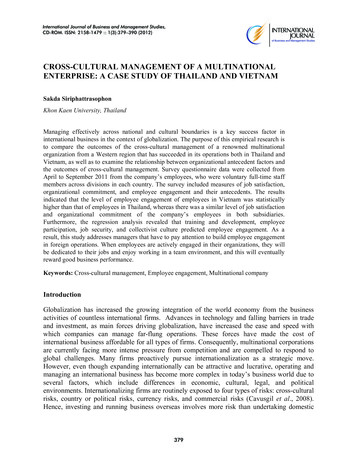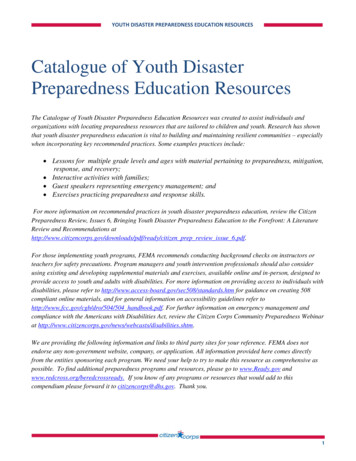
Transcription
International Journal of Business and Management Studies,CD-ROM. ISSN: 2158-1479 :: 1(3):379–390 (2012)CROSS-CULTURAL MANAGEMENT OF A MULTINATIONALENTERPRISE: A CASE STUDY OF THAILAND AND VIETNAMSakda SiriphattrasophonKhon Kaen University, ThailandManaging effectively across national and cultural boundaries is a key success factor ininternational business in the context of globalization. The purpose of this empirical research isto compare the outcomes of the cross-cultural management of a renowned multinationalorganization from a Western region that has succeeded in its operations both in Thailand andVietnam, as well as to examine the relationship between organizational antecedent factors andthe outcomes of cross-cultural management. Survey questionnaire data were collected fromApril to September 2011 from the company’s employees, who were voluntary full-time staffmembers across divisions in each country. The survey included measures of job satisfaction,organizational commitment, and employee engagement and their antecedents. The resultsindicated that the level of employee engagement of employees in Vietnam was statisticallyhigher than that of employees in Thailand, whereas there was a similar level of job satisfactionand organizational commitment of the company’s employees in both subsidiaries.Furthermore, the regression analysis revealed that training and development, employeeparticipation, job security, and collectivist culture predicted employee engagement. As aresult, this study addresses managers that have to pay attention to build employee engagementin foreign operations. When employees are actively engaged in their organizations, they willbe dedicated to their jobs and enjoy working in a team environment, and this will eventuallyreward good business performance.Keywords: Cross-cultural management, Employee engagement, Multinational companyIntroductionGlobalization has increased the growing integration of the world economy from the businessactivities of countless international firms. Advances in technology and falling barriers in tradeand investment, as main forces driving globalization, have increased the ease and speed withwhich companies can manage far-flung operations. These forces have made the cost ofinternational business affordable for all types of firms. Consequently, multinational corporationsare currently facing more intense pressure from competition and are compelled to respond toglobal challenges. Many firms proactively pursue internationalization as a strategic move.However, even though expanding internationally can be attractive and lucrative, operating andmanaging an international business has become more complex in today’s business world due toseveral factors, which include differences in economic, cultural, legal, and politicalenvironments. Internationalizing firms are routinely exposed to four types of risks: cross-culturalrisks, country or political risks, currency risks, and commercial risks (Cavusgil et al., 2008).Hence, investing and running business overseas involves more risk than undertaking domestic379
380Sakda Siriphattrasophonbusiness. Among all international business risks, cross-cultural discrepancies are inevitable inparticular because human resources are required at all operational levels and across all businessunits. Therefore, there is a need to manage effectively the cross-culture aspect of humanresources for the success of international organizations.According to Gancel et al. (2002), the failure of cross-cultural management stems from anumber of reasons: insufficient cross-cultural awareness—managers that are not aware of thevery existence of the cultural dimension of management; insufficient understanding—managersknow about the existence of culture, but they do not understand this issue and thus underestimatethe impact that culture can have on business and do not have any need to deal with it; insufficientwillingness—managers knowingly decided not to deal with culture; and insufficient level ofabilities and skills—managers may be aware of and may even try to manage the culture but faildue to a lack of intercultural competence. Many scholars finally conclude that effective crosscultural management can become a critical source for increasing business competitiveness,which in turn can lead to success in international business.Multinational companies have played an important role in international business. As definedby Cavusgil et al. (2008), a multinational enterprise is a large company with substantialresources that performs various business activities through a network of subsidiaries andaffiliates located in multiple countries. The main reason for the expansion of multinationalcompanies is to create global competitiveness by reducing production costs and exploitingmarket opportunities offered by trade liberalization and economic integration. The growing roleof multinational firms has increased the volume of international trading and has stimulatedbusinesses to become more competitive in the global market. Besides, the emergence ofmultination corporations has also increased the degree of global interdependence.International business requires special knowledge, commitment of resources, andconsiderable time to develop the success of foreign operations. Being large organizations,multinational enterprises are not constrained by limited financial or human resources. Hence, thisresearch places substantial emphasis on the case study of a leading multinational enterpriseproducing and distributing consumer products from a Western region that has successfullyexpanded across national borders. The company has been able to create a competitive advantageto outperform its competitors, both locally and internationally, by managing effectively humanresources across national and cultural boundaries.This multinational firm has been also expanding its operations into Thailand and Vietnamover the past decades. Learning from the study of a well-performed multinational organizationnot only advances knowledge in the field of cross-cultural management as for businesses that areconsidering entering emerging markets, particular in Thailand and Vietnam.Literature ReviewCross-cultural management is obviously important and has a great effect on the success ofoverseas business operations. Cullen and Parvoteeah (2008) have reported that internationalbusiness management is inseparable from the sphere of patterned cultural behaviors becauseculture is represented in terms of the pervasive and shared beliefs, norms, values, and symbolsthat guide the everyday life of different groups of people. International managers have to decideto choose and adjust their strategies aligned with each country’s culture. Appropriate businessstrategies can be used to reduce possible risks and impacts, of cross-cultural discrepancy anddeliver successful outcomes for their own enterprises.
Cross-Cultural Management of a Multinational Enterprise.381According to Cullen and Parboteeah (2008), culture can be generally classified into threemajor levels: (i) National Culture - the dominant culture within the political boundaries of thenation-state; (ii) Business culture – the norms, values, and beliefs that pertain to business in aculture (i.e. acceptable ways to conduct business in a society); and (iii) occupational andorganizational culture. Occupational culture refers to the norms, values, beliefs, and expectedways of behaving for people in the same occupational group, while organizational culture is theset of important understandings that members of an organization share. All of the levels of crosscultural differences affect all interactions of business as well as business performance.Smith et al. (2008) presents a conceptual framework on the factors affecting cross-countrydifferences. This framework is associated with economic development, political/social history,and national cultures (norms, values, and beliefs), which has a powerful influence on socialnorms and the role of an organization, as well as social character traits (values, role definitions,motivations, and perceptions). These have influenced organizational citizenship behavior (OCB)and have had an important impact on organizational outcomes such as organizationalperformance, team performance, and individual performance ratings. In the meantime,moreover, there are several antecedents that also affect OCB, such as organizational contexts,attitudes, etc.Outcomes of Cross-cultural ManagementThe evaluation framework of organizational outcomes has been developed according to variousapproaches. For instance, organizational effectiveness has been considered as an organizationthat achieves its short-term goals/ends and/or long-term goals with accomplishment of therequired or an above-standard of organization. As a consequence, evaluations should focus onmany aspects of an organization and its processes, for example, its finance and employeesatisfaction (Cameron, 2005). A number of studies, in addition, have also clearly shown thatorganizational commitment and employee engagement are closely associated with theeffectiveness and business performance of organizations (Meyer and Allen, 1997; Saks, 2006;Wagner and Harter, 2006; Hackman and Oldham, 1980). These critical factors can be used toreflect the outcomes for organizational management and key success indicators of firms.Employee or job satisfaction is defined as employees’ positive attitude towards their job andoverall work situation which results from perception and other assessments. This satisfaction ismotivated by task fulfillment and the goal achievement of the organization (Hackman andOldham, 1980). All employees that will have job satisfaction need to be motivated properly. Jobsatisfaction can create intrinsic enthusiasm on the part of the employee and drive him or her toaccomplish his or her work. As a consequence, job satisfaction is “an important workplaceconstruct and one that is of concern for effective management” (Boles et al., 2001).Studies of work satisfaction have been carried out in the past decades. For example,Mowday et al. (1979) conducted research on the relationship between employees’ worksatisfaction and business performance. The study of Shalley et al. (2000) found that 2,200technical professionals having higher job satisfaction levels were associated with lower intentionto leave the company. Low levels of job satisfaction among employees are related to variousundesirable behaviors, such as quitting their job, as well as psychological components associatedwith turnover. These behaviors also included thoughts of quitting and the intention to quit (Homet al., 1992). When job satisfaction is low, employees are statistically more likely to quit thanthose with higher levels of satisfaction. Levels of job satisfaction are the major causes of laborstrikes, persistent tardiness, and work stoppage and labor turnover. These labor issues are
382Sakda Siriphattrasophondirectly associated with higher costs in employment (Voros, 2000). Low job satisfaction alsoreduces employee productivity (Keller et al., 1996).Meyer and Allen (1991) have defined organizational commitment as a heightened emotionalconnection that employees feel for their organization’s goals and values—employees aredetermined to participate in the activities of their organization. Engaged employees also tend towork with dedication. According to Meyer and Becker (2004) and Meyer and Allen (1997),many studies over the past decade have shown a positive correlation between organizationalcommitment and firm performance. An increase in organizational commitment is highly likely tocontribute to an increase in an organization’s benefits, as with the following: (i) improvingemployee motivation can directly reduce absentee rates, and increase employees’ enthusiasm; (ii)reducing the employees’ turnover rates (highly-committed employees experience significantlyfewer thoughts of quitting and they tend to stay much longer in their employment); and (iii)highly-committed employees exhibit good job performance because they are more willing tofulfill their obligations to their organization. Therefore, organizational commitment is crucial forcreating a productive workplace on the part of every executive. It also helps employees tobecome more motivated and reduces counterproductive work behaviors that prevent theorganization from accomplishing its objectives.Employee engagement similarly refers to the internal characteristics whereby employeeswill perform well and be engaged in the organization they belong to when they have positiveattitudes toward tasks, their peers and themselves (Saks, 2006). Harter et al. (2002) believed that,in general, employee engagement is constantly related to good business performance. Bates’(2004) study, in particular, clearly showed that employee engagement can be adopted to predictoutcomes of employee performance and organizational success, including financial performance.Kahn (1992) previously explained that high levels of engagement can lead to positiveoutcomes for both individuals (quality of work) and organizations (productivity). Saks (2006)additionally reviewed research related to the field and found that employee engagementprofoundly influenced the positive business outcomes for every organization in many aspects,such as job satisfaction, organizational commitment, turnover rate, and organizational citizenshipbehavior. For this reason, engagement in a workplace creates positive work-related experienceand a state of mind towards employees that have a healthy work force and positive workperformance. Moreover, highly-engaged employees are less inclined to resign from their jobs—they are reliable and maintain a good relationship with their employer. Employees feel moreenergetic and dedicated when they have a positive attitude toward the work environment.Maslach et al. (2001) also found that employee engagement was a mediating variable that linkedthe relevant factors concerning the work environment and other outcomes, such as turnover rate,job satisfaction, and commitment.Antecedents of Cross-cultural ManagementOne important theory related to cross-cultural management can be found in Hofstede’s research(1984). His findings revealed that an organization can be seen as a small unit of the nationalculture. In a behavioral study of employees in a multinational company, he divided nationalcultures into four dimensions: power distance represents inequality; uncertainty avoidance refersto a preference for structured situations rather than unstructured situations; collectivism indicatesstrong cohesiveness in groups; and masculinity is the result of widely-accepted male ways ofthinking. His research showed that a national culture has a major impact on employees’ workrelated values and attitudes. These four dimensions refer to cultural characteristics that can be
Cross-Cultural Management of a Multinational Enterprise.383used to predict the behaviors of an aggregate population and yield many advantages in managingthe culturally-diverse workforce in today’s organizations. Hofstede’s theory is partly adopted inthis study in order to investigate the impact of culture on aspects of cross-cultural management,such as job satisfaction, organizational commitment, and employee engagement.Although cultural factors affect the outcomes of organizational management, a number ofstudies have referred to factors outside cultural factors, such as that of Hackman and Oldham(1980), who demonstrated that job characteristics (such as skill variety, task identity, tasksignificance, autonomy) provided employees to be more engaged. In contrast, perceptions of jobinsecurity might tend to diminish attachment to work and organization (Pfeffer, 1994).Regarding Mathieu’s study (1991), moreover, it was found that the prestige of the organizationcan be used to meet the self-esteem needs of employees and provide employees with theimportant factors required to continuously create organizational commitment. Sayeed’s study(2001) also revealed that most committed professional managers paid attention to their corporateimage rather than financial returns or benefits. Additionally, management practices such as wagepayment systems, appraisal and reward systems, employee involvement, and training andculture-related development will affect employees’ organizational commitment (Sakda, 2008).MethodologyThis exploratory and empirical research examines the cross-cultural management practices of asuccessful multinational enterprise operating in Thailand and Vietnam. This research also aims atidentifying the relationship between antecedents and outcomes of cross-cultural management. Inorder to achieve these objectives, the following research methodology was employed.Sample and Data CollectionThe participants of this research were full-time staff members employed for at least one yearacross divisions in the selected multinational enterprise based in its Thailand and Vietnambranches. The staff had to have been working in the organization long enough to be able tospecify, recognize, and get acquainted with the company’s culture, management practices, andwork environment. The data collection method was a self-administrated questionnaire. Theresearch period was between April and September 2010.With letters of request to conduct this study sent to the management of the country, 400questionnaires were distributed to the company in Thailand and Vietnam (200 sets per branch).The researcher received 125 returned questionnaires from the company in Thailand and 143returned questionnaires from the branch in Vietnam. After eliminating incomplete answers,however, the number of completed questionnaires that were usable for the analysis was 118 and136 for the Thai and Vietnamese branches respectively. The final response rate and detailanalyses of the demographic variables are provided in Table 1.
384Sakda SiriphattrasophonTable 1. Participants and sample descriptive statistics.No. of participants (Response rate)Age: mean (S.D.)Gender: FemaleEducation Level:Below bachelorBachelor's degreeHigher than bachelorManagerial position:Non-managementMiddle managementTop managementWork experience:1-5 years6-10 yearsMore than 10 yearsThailandVietnamTotal118 (59.0%)33.0 (6.48)66.9%136 (68.0%)30.2 (6.67)55.5%254 (63.5%)31.48 e data collection instrument for this research was a questionnaire that was adopted fromseveral researchers and partly developed by the author with the assistance of the HR heads of thetarget company. The developed questionnaire aimed to measure the cross-cultural managementoutcomes and antecedents of the selected multinational enterprise in its operations in Thailandand Vietnam.The dependent variables were questions related to three cross-cultural managementoutcomes, which consisted of the concept of organizational commitment developed by Meyerand Allen (1997), and employee engagement and job satisfaction derived by Saks (2006). Eachdimension was based on a 5-point rating scale, where respondents were allowed to choose fromstrongly disagree (1) to strongly agree (5). A higher level of outcome in each dimension wasindicated by a higher mean score.The two independent variables were questions related to cross-cultural managementantecedents, organizational culture, and organization context. For organizational culture, thedimensions representing organizational culture were adapted from Hofstede’s theory of workrelated culture value (1984). Since the masculinity dimension that justified such culture mighthave been inappropriate for this study, the researcher decided to study only three dimensions. Tomeasure the organizational contexts, the combined questionnaire was adapted from Hackmanand Oldham (1980) and Sakda (2008). Each item was similarly measured on a 5-point ratingscale, where respondents were also allowed to choose from strongly disagree (1) to stronglyagree (5). A high mean score represents strong culture and/or strong context in the organization.The questionnaire used for this research measured validity by consulting experts andspecialists in the field; furthermore, pre-testing with 30 samples was done in order to verify thereliability by using Cronbach’s alpha-coefficient method. According to the reliability tests,organizational commitment, employee engagement, and job satisfaction demonstrated Cronbach
Cross-Cultural Management of a Multinational Enterprise.385Alpha-Coefficients of 0.81, 0.84, and 0.73, respectively. That is, all of the variables hadreliability higher than the typical acceptable level of .70 (Hair et al., 1998).Data AnalysisDescriptive statistics were used to describe the profile of the respondents and to summarize thevariables; additionally, inferential statistics were used to test the hypothesis. In order toaccomplish the research objectives, the statistical analysis was divided into two hypothesestesting: In order to test the mean differences of the variables related to outcomes as well ascharacteristics related to cross-cultural management between the branches in Thailand andVietnam, an independent-sample-t-test was used for the comparison;In order to better understand the relationships among the variables, Pearson’s productmoment correlation coefficient analysis was performed to generate the correlation matrix anda multiple regression was applied. This statistical method was considered appropriate, as allconcerned variables were measured on an interval scale. As there were multiple items foreach construct, the average of the multiple items was used in the multiple regression.For the purpose of statistical testing, all tests were conducted at a .05 level of significance.Results and DiscussionThe results of the study of cross-cultural management of the multinational enterprise operating inThailand and Vietnam can be addressed as follows:Cross-cultural Management OutcomesThe analysis and comparison results of the outcomes of cross-cultural management in the presentstudy are presented in Table 2. Data from Table 2 demonstrated that job satisfaction and theorganizational commitment of employees in Thailand and Vietnam were not statisticallysignificant, whereas the level of employee engagement in Vietnam was higher than that ofThailand. These findings might be a reason why the business results (in terms of sales growthrate) of the company in Vietnam were better than those of Thailand during the past few years.According to several previous studies, employee engagement is related to employeeperformance, organization outcomes, as well as revenues (Saks, 2006; Bates, 2004; Wagner andHarter, 2006).Unlike job satisfaction, which can be defined as an individual’s attitude toward his or herwork, or organizational commitment that refers to an employees’ attitude and attachment towardtheir organization, employee engagement is the degree to which an employee is attentive andabsorbed in the performance of their role (Saks, 2006). Employee engagement is also defined asa fully-engaged employee and as someone that has cognitive understanding of the organization’sstrategic goals and values, has an affective attachment to the organization’s strategic goals andvalues, and has a willingness to do more than the minimum in his/her role (Towers Perrin-ISR,2006). Hence, employee engagement is a culmination of affective commitment, goal alignment,and organizational citizenship behavior. In short, job satisfaction and organizational commitment
386Sakda Siriphattrasophoncould be related to organizational performance but at a lower level than that of employeeengagement.Table 2. Means and t-test results of outcomes of cross-cultural eSDJob satisfaction3.86.563.90.44.64Organizational commitment3.27.503.35.37.16Employee engagement3.57.593.74.30.01** Statistically significant at the p .05 level (2-tailed)Antecedents to the Cross-cultural ManagementThe comparison results of the organizational culture and organizational contexts as theantecedents to the cross-cultural management in the multinational enterprise’s in both the Thaiand Vietnamese branches are shown in Table 3. Data from the table indicate that the employeesin Thailand viewed that the image of the company was better than that of the employees inVietnam, whereas the collectivist culture and employee participation in Vietnam were strongerthan the average results gathered from employees in Thailand. The other dimensions oforganizations contexts were not statistically significant. This may be because both operations arestill working under the same management practices designed and assigned by the globalheadquarters.Table 3. Means and t-test results of antecedents to the cross-cultural ueSDOrganizational culturesPower distanceUncertainty 43.72.56.59.72.20.52.02*Organizational contextsOrganizational reputationJob securityCompensationRewards and recognitionEmployee participationTraining and 62.43.11.01*.67* Statistically significant at the p .05 level (2-tailed)According to the study results, it was observed that Vietnam culture has dominatedorganizational outcomes. For instance, the higher collectivist culture in Vietnam enhanced teamcollaboration, which led to a higher level of employee participation. According to Allen andMeyer (1991), employee perception in participative management makes employees realize theirown duties in the organization. Furthermore, organizations those allow employees to be involvedin the decision-making process, both in planning and operating, and distributing decision-makingpower to all levels, develop employees that will commit to them (Hrebiniak and Allutto, 1992).However, since Thailand’s branch was established several decades before the one inVietnam, the image of the company in Thailand was perceived to be better than in Vietnam
Cross-Cultural Management of a Multinational Enterprise.387according to the employee’s point of view. Nonetheless, it seems that the higher organizationalreputation did not affect any of the cross-cultural management outcomes in this study.The correlation between cross-cultural management antecedents and outcomesThe correlation matrix of the variables in the regression model is given in Table 4. As can beseen, all of the measures of cross-cultural management outcomes were significantly andpositively correlated among themselves (p-value .01). Both job satisfaction and organizationalcommitment were moderately and equally related to employee engagement, yet a weakerassociation was found between job satisfaction and organizational commitment. In addition, themeasures of cross-cultural management antecedents were also significantly and positivelycorrelated with the measures of all of the outcomes. It was noted, however, that only uncertaintyavoidance culture had less or no correlation with some of the measures of organizationalcontexts.Table 4. Pearson’s correlation of outcomes of cultural management and organizational factors.No.123456789101112VariableJob satisfactionOrganizational commitmentEmployee engagementOrganizational reputationJob securityPower distanceUncertainty avoidanceCollectivismCompensationRewards and recognitionEmployee participationTraining and 10111.011.34** .18** 1.39** .05 .22** 1.54** .03 .37** .61** 1.31** .15* .22** .22** .38** 1.33** .18** .25** .45** .46** .27**121** Correlation was statistically significant at the 0.01 levelWith regard to the analysis results in Table 2, only the employee engagement outcome ineach branch of the company was different, and researcher further investigated to find thevariables affecting employee engagement by using multiple regression analysis. According to thehypothesis testing, the antecedent variables affecting employee engagement consisted of jobsecurity (Coefficient .15, p-value .006), collectivist culture (Coefficient .15, p-value .004),training and development (Coefficient .20, p-value .000), and employee participation(Coefficient .28, p-value .000). The regression model was significant (p-value .000) and hadan R2 of .52. That is, 52% of the variation in employee engagement can be explained by thevariation in the cross-cultural management antecedent variables in the organization.The results of the multiple regression analysis revealed some organizational culture andcontext variables that enhance employee engagement in the organization. Among these variables,employee participation had the highest association with the engagement. As reported by Pfefferand Viega (1999), promoting employee participation could lead to higher job responsibility andencourage a sense of creativity and ownership in solving problems and achieving the targets aspart of the organization. The second variable that affected engagement was training anddevelopment, since an intensive training could stimulate the feeling of importance of employeesto the organization and promote self-development (McElory, 2001).
388Sakda SiriphattrasophonAdditionally, the collectivist culture that had been dominated by the national culture was thethird variable associated with engagement. Since a collectivist culture has been defined here asthe tendency of people to regard themselves as part of a group or team (Hofstede, 1984), it islikely from the evidence that collectivism can promote employee part
ENTERPRISE: A CASE STUDY OF THAILAND AND VIETNAM Sakda Siriphattrasophon Khon Kaen University, Thailand Managing effectively across national and cultural boundaries is a key success factor in international business in the context of











